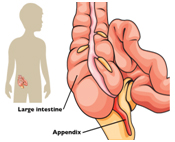Appendicitis, perforated with abscess
What is a perforated appendicitis?
Appendicitis (ah-pen-dih-site-iss) is inflammation of the appendix, a small worm-shaped structure that's attached to the large intestine in the lower right side of the abdomen (see picture). If the opening to the appendix gets blocked by material from the intestine, it becomes irritated, swollen, and infected. Sometimes an infection of the appendix causes a hole that allows the infection to spread to the rest of the abdomen. This is called a “perforated” or “ruptured” appendicitis.

What is an abscess?
An abscess is a collection of infection that has built up inside the abdomen.
How is it treated?
The treatment for a perforated appendicitis with abscess begins with hydration and antibiotics.
We then ask the radiology health care practitioner if the abscess can be drained. Drainage of the abscess is performed under sedation. An ultrasound or CT scan guides the radiologist. A small tube is placed into the abscess to drain the infection. Sometimes they are unable to place a drain and they will simply suck out as much fluid as possible. Either way, your child will stay in the hospital and receive IV antibiotics until the drain is removed and he/she is no longer having fevers, has adequate pain control, and is tolerating a regular diet.
If the radiologist cannot drain the abscess, your child will remain in the hospital receiving IV antibiotics until he/she is no longer having fevers, has adequate pain control, and is tolerating a regular diet.
Once your child meets the discharge criteria he/she will be sent home to recover for a period of 6-8 weeks. During that time your child can return to school and regular activities. After 6-8 weeks your child will return to the hospital to have his/her appendix surgically removed in order to prevent the appendicitis from returning. Most children stay overnight after that surgery and are able to return to normal activities within 2-3 days.
When will my child be discharged?
Your child will remain in the hospital until the drain is removed.
Your child may be discharged from the hospital when:
- There is no fever for 24 hours;
- Eating and drinking enough to stay hydrated;
- Pain controlled with medicines taken by mouth.
How should I care for my child at home?
- No tub bathing or swimming for 7 days. It is ok to shower and let water run over the dressing/incision.
- Children usually go back to school within 7-10 days after discharge.
- Gym and sports may be resumed as tolerated.
- Schedule a post-op appointment to be seen by the surgeon. Your health care practitioner will let you know when to come back, usually in 2-4 weeks.
When should I call the health care practitioner?
- Fever (temperature over 101° F)
- Abdominal pain
- Nausea/vomiting
- Diarrhea
- Wound infection (redness, swelling, drainage, tenderness)
Last reviewed 1/2016
This page is not specific to your child, but provides general information on the topic above. If you have any questions, please call your clinic. For more reading material about this and other health topics, please call or visit Children's Minnesota Family Resource Center library, or visit www.childrensmn.org/educationmaterials.
© 2024 Children's Minnesota
